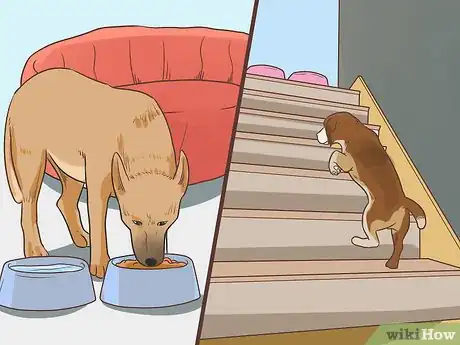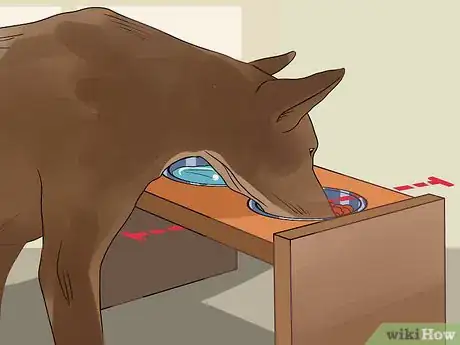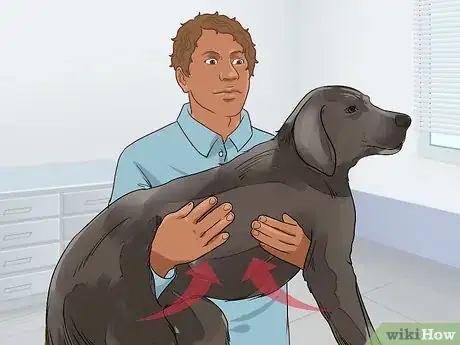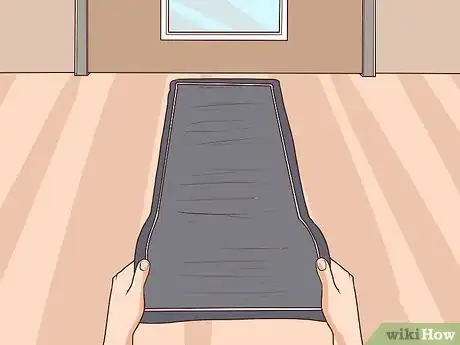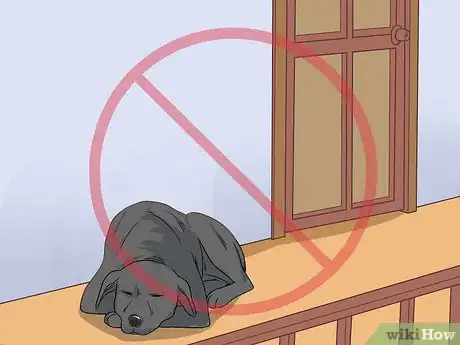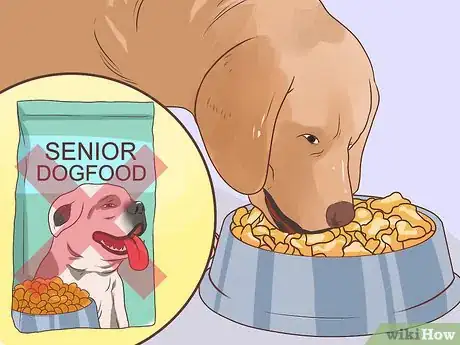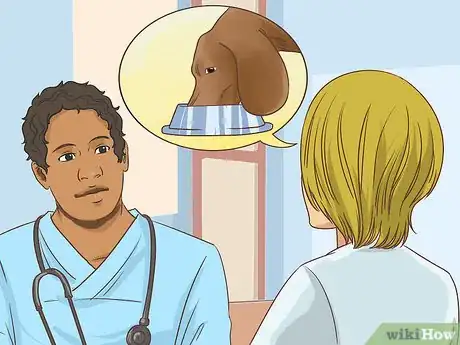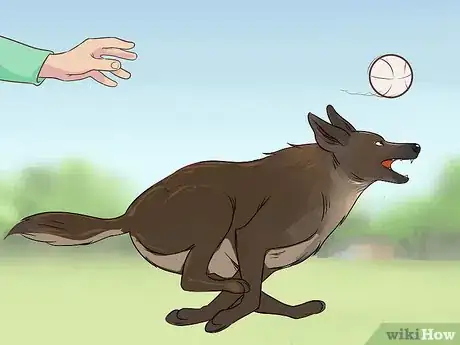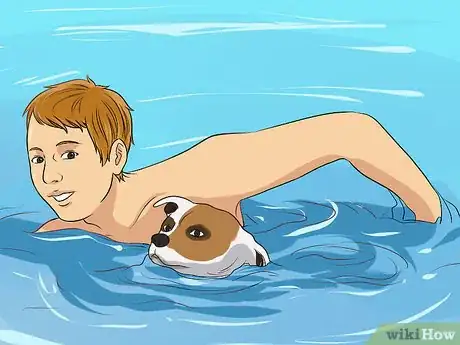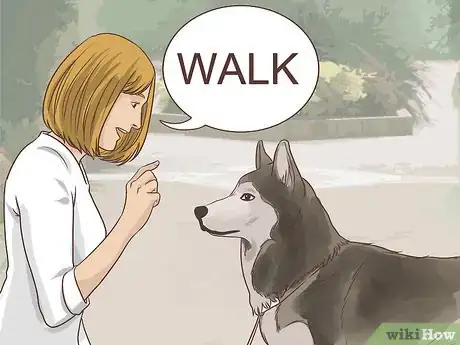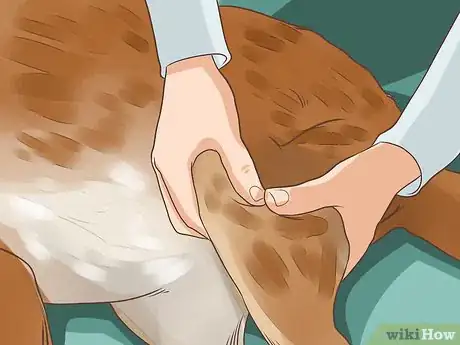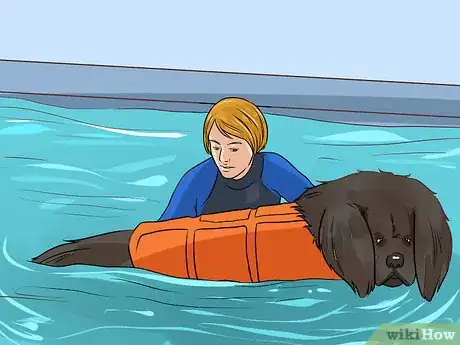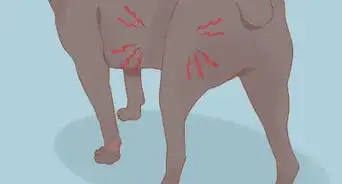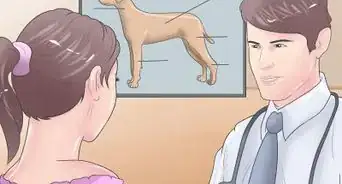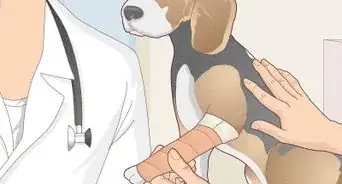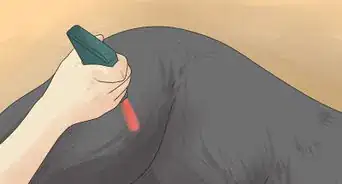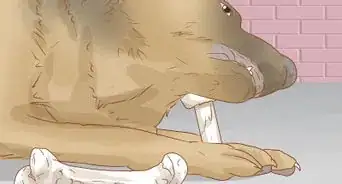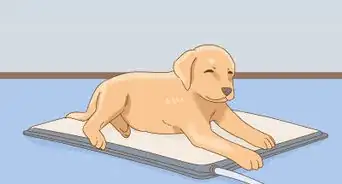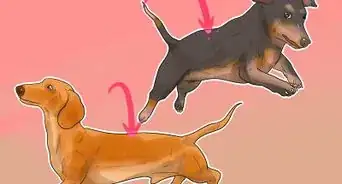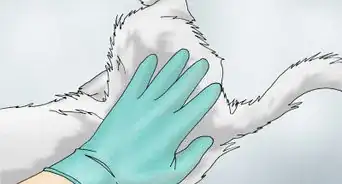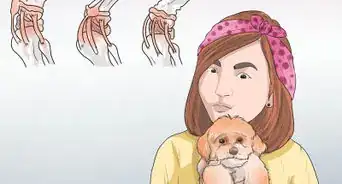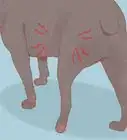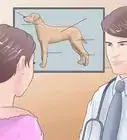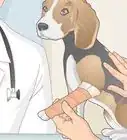This article was co-authored by Dee Hoult. Dee Hoult is the CEO of Applause Your Paws, Inc., South Florida's largest privately-owned dog training company. With over 15 years of experience, Dee specializes in correcting dog behavior problems by providing engaging, positive education and non-intimidating training. Dee holds a BS in Marine Science and Biology and an MBA from the University of Miami. She is a credentialed Certified Professional Dog Trainer through the Certification Council for Professional Dog Trainers and a credentialed Certified Dog Behavior Consultant (CDBC) through the International Association of Applied Behavior Consultants (IAABC). In 2018, Dee was a finalist for Woman of the Year for the Women in the Pet Industry Awards.
There are 17 references cited in this article, which can be found at the bottom of the page.
This article has been viewed 20,458 times.
Morning stiffness, to one degree or another, is almost inevitable as your dog ages. The best ways to deal with morning stiffness in your elderly dog is to accommodate them as much as possible by providing raised food dishes at breakfast and help them up and down furniture. Ensuring your dog stays warm at night can also prevent it from waking up feeling stiff and sore. Contact your vet as soon as you notice your dog losing mobility in the mornings. Your vet might recommend dietary or lifestyle changes to strengthen your dog’s joints and muscles. Other medical interventions you might want to try include acupuncture, hydrotherapy, and massage therapy.
Steps
Making Life Easier
-
1Keep food and water dishes within easy reach. If your dog is stiff in the morning, don’t force them to climb up or down stairs in order to get breakfast. Place the dishes on the same level of the house that the dog sleeps on. By the time doggie has had a bit to eat and walked around a bit, they should have worked a bit of their stiffness out.[1] [2]
-
2Use raised bowls. Larger dogs might develop stiffness in their necks as they get older. In order to help them during breakfast, place their food and water dishes on a low platform or step-stool. The raised dishes should be at the level of their mouth. This will save them the trouble of needing to crane their neck downwards to eat.[3]Advertisement
-
3Give your dog a helping hand. If your dog needs help jumping up on furniture or on the bed in the morning because it is too stiff, help your dog up. Lift your dog gently by cupping it beneath its “armpits” – the spot where its front legs and body meet. [4]
- You might also place a low stepping stool in front of couches or bed in order to enable your dog to climb onto them itself.[5]
- Always be gentle with your dog and respond to any signals it gives that you’re pulling too hard. If your dog yelps or cries out, don’t insist on pulling your dog up onto furniture.
-
4Cover slippery floors. Old dogs may have trouble walking steadily on laminate or linoleum floors. Provide non-slip runners for your dog to walk along.
Giving Your Dog a Good Night’s Sleep
-
1Keep your dog warm. Drops in temperature can affect the joints of older dogs more than younger dogs. Place an electric blanket or heating pad beneath your dog’s bed at night. Keep the setting as low as possible at first. Gradually increase the temperature until you see a reduction in your dog’s stiffness in the morning.[6]
- If you notice your dog sleeping elsewhere, rather than its normal bed where the heating pad is under it, you probably have the electric blanket or pad turned up too high. Reduce the temperature to a comfortable level.
- Likewise, if your dog is getting up in the middle of the night, or going back and forth between its bed with the heat source beneath it and another, cooler area of the house, you should turn the heat down.
-
2Don’t let your dog sleep outside. Some dogs love spending all their time in their doghouse. But as your dog ages, it might become more susceptible to dips in temperature that never bothered it when it was younger. Insist that your elderly dog sleeps inside in order to prevent the cold from leaving your doggie stiff in the morning.[7]
- Provide a soft, warm bed so your dog doesn’t miss the doghouse.
-
3Provide the right bed. Memory foam beds are best for dogs that have problems with mobility. They provide extra support for sore joints and ensure your elderly dog gets the best night’s rest it possibly can. Memory foam dog beds are available online and in most pet stores.
Improving Your Dog’s Diet
-
1Keep your dog lean. If your dog is too fat, it will have trouble moving and experience inflammation of the joints, which limits mobility in mornings. Carrying around a lot of extra pounds is hard on the skeleton and joints. Plus, obesity in dogs (as in people) also leaves them open to a host of other maladies, including diabetes, heart disease, and high blood pressure.[8]
- Overweight dogs will suffer from stiffness. But your dog should also not be too skinny.
- The ideal dog weight is one in which you can feel the ribs, but they are not poking out. Your dog’s abdomen should appear tucked – not hanging – when viewed from the side.[9]
-
2Add supplements. Supplements that improve joint health can help relieve your dog’s morning stiffness. They are available in oral, liquid, and (with a veterinarian prescription) injectable forms. Fish oil – used to improve joint support – is one of the most common doggie supplements. Other popular supplements the provide similar effects include glucosamine and chondroitin, which are often available in one combination supplement. Hyaluronic acid can also help lubricate joints for increased morning mobility.[10]
- Always follow manufacturer directions when administering supplements. Only give your dog as much as is appropriate based on its age and weight.
-
3Don’t assume a senior dog food is best for your dog. Most dog food manufacturers offer dog foods designed specifically with older dogs in mind. These dog foods might have lower calorie counts per serving, or have increased levels of fiber. But these dog foods are not necessarily what your dog needs. If your dog remains active into its golden years, it might need a regular, higher-calorie dog food.
- Ask your vet about recommendations regarding its diet.
-
4Talk to your vet.[11] Your vet might have specific recommendations about your pet’s diet based on its health history and species. Explain the situation to your vet and let them know what you feed your dog. Ask, “Do you have any recommendations about what I should be feeding my dog to reduce its morning stiffness?”[12]
Providing Adequate Exercise
-
1Take your dog walking. A daily walk will help your dog stay fit and trim. Strap on the leash and take your dog around the block. Or you could head to your local park and give your dog a chance to encounter some new sights and smells.
- Proceed slowly at first, but don’t let your dog linger or walk lazily.
- The more intense your dog’s walk, the better the benefits you will both reap.
- Don’t push your elderly dog beyond what it is capable of. If your dog starts to slow down noticeably, reduce your pace and head for home.
-
2Play with your dog. Games and play are great for keeping your elderly dog active. For instance, toss your dog’s favorite toy or ball across the room. Better yet, head outside to a space where your dog has lots of space to run about. After tossing the toy, encourage your dog to bring it back to you. Repeat several times until your dog is tired. This simple game will improve your dog’s circulation and flexibility, leading to less morning stiffness.[13]
- Playing with your dog is good for its mental and emotional health.
-
3Go for a swim.[14] When your dog is swimming, the water’s buoyancy lifts and supports your dog, allowing it to move about more freely than it would otherwise. Take your doggie to the lake or a slow-moving stream or river for a fun summer outing that can improve your dog’s mobility.
-
4Make the exercise fun. Let your dog know before heading out to play or go for a walk. For instance, say “Walk?” repeatedly to your dog in an excited voice before heading out for a walk. Pet your dog lovingly as you say it. Over time, your dog will come to associate this word and the subsequent walk with the good feelings it has due to being paid attention and petted.[15]
- After your walk is finished, pet your dog several more times and say “Good boy/girl” affectionately.
Adopting Medical Interventions
-
1Talk to your vet. The first course of action when dealing with stiffness in dogs – no matter the time of day – should be to talk to your vet.[16] Your vet might be able to recommend solutions or managements techniques specific to your pet based on its health history and species.[17]
- Your dog might be able to prescribe medication for your dog to help it cope with the stiffness in its joints.
- You should already have a vet for your older dog, but if you don’t, check online veterinary organization databases. The American Animal Hospital Association, for instance, has a searchable list of animal treatment centers at https://www.aaha.org/your-pet/hospital-locator/.
-
2Try surgery. If your vet thinks it is appropriate, you might be able to improve your dog’s morning stiffness through surgery. Canine surgeons can provide added stability to joints and remove bits of bone that may have chipped off over time. Smaller dogs might benefit from having certain leg joints fused, or having the top portion of upper leg bones removed.[18]
- Talk to your doctor to determine if your dog needs surgery.
-
3Try massage therapy. Dogs, like humans, can benefit tremendously from a good massage. Take your dog to a trained animal masseuse and explain that it experiences stiffness in the morning. Your dog might benefit from a good massage.[19] [20]
- Ask the masseuse for tips about how you might be able to provide a simple massage to your dog in the morning in order to reduce its stiffness. If possible, sit by and carefully watch the pet masseuse as they massage your doggie.
- Massaging your dog yourself can not only save time and money, but provide a great opportunity to improve the bond between you.
-
4Try acupuncture. Acupuncture – the application of needles to various points on the body – isn’t just for people. This traditional Chinese health practice can make your dog more mobile and active in the morning, afternoon, or evening. Contact some traditional Chinese medical specialists and ask if they perform acupuncture on dogs. If they don’t, ask them if they know of another acupuncturist who does.[21] [22]
-
5Try hydrotherapy. Hydrotherapy is the application of assisted swimming in order to help dogs keep their muscles and joints active. Dogs can more easily move around in water than they can on land because in water, they float. While floating, stress on joints and muscles is reduced. A hydrotherapy session might use underwater treadmills or jet pools in order to help your dog improve use of its limbs and stay limber.[23]
- Ask your vet for recommendations of doggie hydrotherapy centers near you.
Expert Q&A
-
QuestionIs it safe to exercise my dog when she gets stiff?
 Dee HoultDee Hoult is the CEO of Applause Your Paws, Inc., South Florida's largest privately-owned dog training company. With over 15 years of experience, Dee specializes in correcting dog behavior problems by providing engaging, positive education and non-intimidating training. Dee holds a BS in Marine Science and Biology and an MBA from the University of Miami. She is a credentialed Certified Professional Dog Trainer through the Certification Council for Professional Dog Trainers and a credentialed Certified Dog Behavior Consultant (CDBC) through the International Association of Applied Behavior Consultants (IAABC). In 2018, Dee was a finalist for Woman of the Year for the Women in the Pet Industry Awards.
Dee HoultDee Hoult is the CEO of Applause Your Paws, Inc., South Florida's largest privately-owned dog training company. With over 15 years of experience, Dee specializes in correcting dog behavior problems by providing engaging, positive education and non-intimidating training. Dee holds a BS in Marine Science and Biology and an MBA from the University of Miami. She is a credentialed Certified Professional Dog Trainer through the Certification Council for Professional Dog Trainers and a credentialed Certified Dog Behavior Consultant (CDBC) through the International Association of Applied Behavior Consultants (IAABC). In 2018, Dee was a finalist for Woman of the Year for the Women in the Pet Industry Awards.
Certified Dog Behavior Consultant In general, easy-going exercise can actually help dogs stay in shape. However, I recommend you talk to your vet first to figure out if your dog has any physical limitations that will prevent her from exercising.
In general, easy-going exercise can actually help dogs stay in shape. However, I recommend you talk to your vet first to figure out if your dog has any physical limitations that will prevent her from exercising. -
QuestionHow can I exercise my older dog?
 Dee HoultDee Hoult is the CEO of Applause Your Paws, Inc., South Florida's largest privately-owned dog training company. With over 15 years of experience, Dee specializes in correcting dog behavior problems by providing engaging, positive education and non-intimidating training. Dee holds a BS in Marine Science and Biology and an MBA from the University of Miami. She is a credentialed Certified Professional Dog Trainer through the Certification Council for Professional Dog Trainers and a credentialed Certified Dog Behavior Consultant (CDBC) through the International Association of Applied Behavior Consultants (IAABC). In 2018, Dee was a finalist for Woman of the Year for the Women in the Pet Industry Awards.
Dee HoultDee Hoult is the CEO of Applause Your Paws, Inc., South Florida's largest privately-owned dog training company. With over 15 years of experience, Dee specializes in correcting dog behavior problems by providing engaging, positive education and non-intimidating training. Dee holds a BS in Marine Science and Biology and an MBA from the University of Miami. She is a credentialed Certified Professional Dog Trainer through the Certification Council for Professional Dog Trainers and a credentialed Certified Dog Behavior Consultant (CDBC) through the International Association of Applied Behavior Consultants (IAABC). In 2018, Dee was a finalist for Woman of the Year for the Women in the Pet Industry Awards.
Certified Dog Behavior Consultant Try exercising your dog in a pool. Swimming allows your dog to move more freely.
Try exercising your dog in a pool. Swimming allows your dog to move more freely.
Warnings
- Do not administer anti-inflammatory drugs or supplements intended for humans to your dog.[24]⧼thumbs_response⧽
References
- ↑ http://dogtime.com/dog-health/general/687-arthritis-in-dogs-aaha
- ↑ https://pethelpful.com/dogs/Older-Dogs
- ↑ https://pethelpful.com/dogs/Older-Dogs
- ↑ http://dogtime.com/dog-health/general/687-arthritis-in-dogs-aaha
- ↑ http://www.dogingtonpost.com/helping-soothe-your-senior-dogs-aching-joints/
- ↑ http://dogtime.com/dog-health/general/687-arthritis-in-dogs-aaha
- ↑ https://pethelpful.com/dogs/Older-Dogs
- ↑ http://www.whole-dog-journal.com/issues/10_3/features/Canine-Arthritis_15910-1.html
- ↑ https://www.dogfoodadvisor.com/dog-feeding-tips/dog-ideal-weight/
- ↑ http://www.whole-dog-journal.com/issues/17_16/features/Your-Dogs-Golden-Years_21184-1.html
- ↑ Dee Hoult. Certified Dog Behavior Consultant. Expert Interview. 15 September 2020.
- ↑ http://www.dogingtonpost.com/helping-soothe-your-senior-dogs-aching-joints/
- ↑ http://dogtime.com/dog-health/general/687-arthritis-in-dogs-aaha
- ↑ Dee Hoult. Certified Dog Behavior Consultant. Expert Interview. 15 September 2020.
- ↑ http://dogtime.com/dog-health/general/687-arthritis-in-dogs-aaha
- ↑ Dee Hoult. Certified Dog Behavior Consultant. Expert Interview. 15 September 2020.
- ↑ http://www.dogingtonpost.com/helping-soothe-your-senior-dogs-aching-joints/
- ↑ http://dogtime.com/dog-health/general/687-arthritis-in-dogs-aaha
- ↑ http://dogtime.com/dog-health/general/687-arthritis-in-dogs-aaha
- ↑ http://www.dogingtonpost.com/helping-soothe-your-senior-dogs-aching-joints/
- ↑ http://www.whole-dog-journal.com/issues/17_16/features/Your-Dogs-Golden-Years_21184-1.html
- ↑ http://www.whole-dog-journal.com/issues/16_11/features/accupuncture-complimentary-healing-method_20859-1.html
- ↑ http://www.dogster.com/lifestyle/dog-health-hydrotherapy-how-it-works
- ↑ http://dogtime.com/dog-health/general/687-arthritis-in-dogs-aaha
About This Article
To deal with morning stiffness in your senior dog, place its food and water dishes on the same level that it sleeps on so it doesn’t have to climb any stairs for breakfast. If your dog is large, put the bowl on a raised platform so it doesn’t have to bend down to eat. Additionally, cover laminate floors with non-slip runners, since your dog may slide on slippery surfaces. In order to ease its stiffness, try giving it fish oil or glycocerine supplements, which can improve joint health. You should also take your dog for a walk every day, which will benefit its joints and overall health. Once you reach an open space, like a park, play a game of fetch with its favorite toy to improve its flexibility and circulation. For tips from our Veterinary co-author, including how to make dietary changes to deal with your dog’s stiffness, keep reading!
